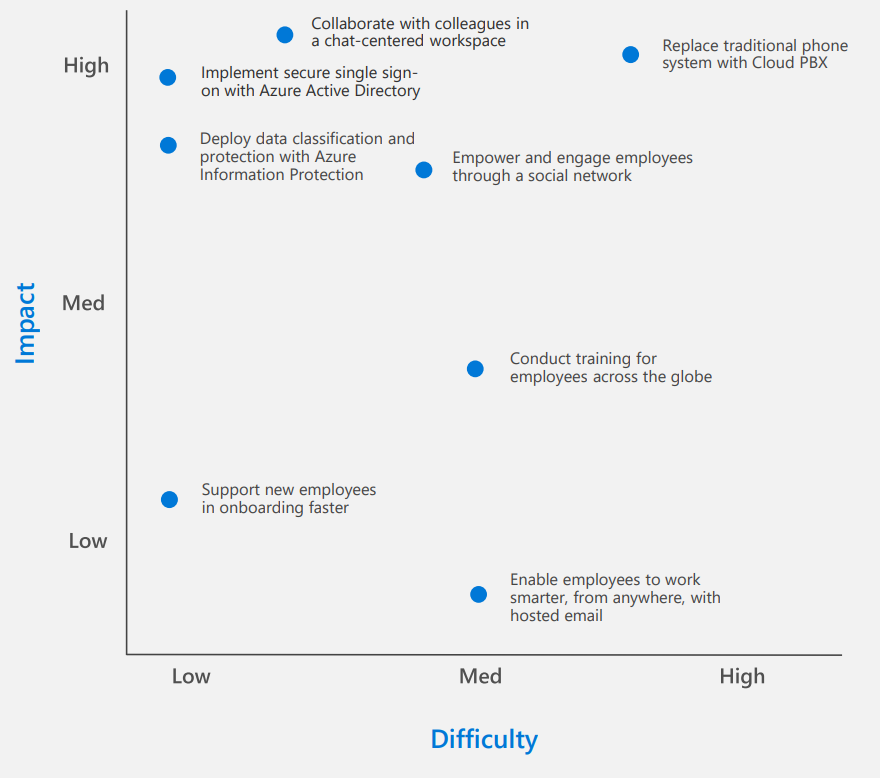Identify and prioritize scenarios
What is a scenario?
Scenarios are the different ways people and teams in an organization can use the new technology to accomplish their goals. They describe how technology will address business challenges and achieve organizational, cultural, tangible, or individual adoption outcomes.
Why are scenarios important?
- They allow teams to understand how the technology can help them achieve more.
- They act as input and validation for awareness messaging.
- They support awareness and readiness activities by putting products in context; people will know when and how to use them.
Identify your scenarios
Begin by identifying scenarios that Copilot for Microsoft 365 can support. Copilot for Microsoft 365 capabilities will inspire you to transform existing business processes and drive innovation across employee experiences. Pinpoint the business areas that are AI-ready for transformation. These scenarios can then be used to help you develop key messaging in your awareness and training engagements.
- Explore the Microsoft Productivity Library, a collection of recommended use cases to showcase ideas on how to use the products to your best advantage and everyday challenges you can solve with Microsoft 365 or Copilot for Microsoft 365 across industries.
- Utilize the Microsoft Copilot for Microsoft 365 Scenario library for guidance on Copilot usage scenarios across individual, role-based, departmental, and organizational levels (HR, Sales, Marketing, Finance, IT). The guide also highlights the value journey from basic usage to extensive integration into business processes. This guide helps start the conversation with business users about their pain points, opportunities, and ideas.
- Take the Empower your workforce with Copilot for Microsoft 365 Use Cases - Training course on Microsoft Learn to build your Copilot for Microsoft 365 skills in various business-related scenarios. Use cases include Executives, Sales, Marketing, Finance, IT, HR, and Operations. This course could inspire you as you identify your scenarios.
- Examples of Copilot specific scenarios in the following chart:
| Creativity | Productivity | Skills |
|---|---|---|
| Provide the impact of a campaign in a visual format | Create a table of pros and cons for a topic | Analyzes a complex sales report |
| Help me write a paper on a topic I know little about | Highlights of a Teams chat with actions | Provide a gap analysis between documents |
| Create a presentation based on a word document | Summarize emails missed while on vacation. Flag important items. | Review business results and summarize key trends |
When choosing scenarios, consider these questions:
- Does it solve a problem?
- Is it obtainable?
- Will it be widely used (how many people)?
- How much return on investment (ROI) does it provide?
Consider using this template when creating AI-ready scenarios for multiple departments and roles:
| Template | As someone in… | I want to… | Using/*Prompt | I’ll know this is successful when… | *The value of Copilot provided me… |
|---|---|---|---|---|---|
| Description | Department/Role | Description of what I want to do | Specific application of the technology | Solutions success measure | *Value associated with Copilot’s help… functional, emotional, social |
| Guidance | [Insert text here describing the person’s role and team.] | [Insert text here describing the job the person wants/needs to complete] | *[Insert text here describing the instructions you would give to Copilot to help you complete this job. The point of the prompt is to think about how and what you think Copilot could do to help you complete this task.] | [Insert text here describing what a successful job completion looks like.] | [Insert text here listing your perception of the value Copilot provided you with in the context of successfully completing the job above.]Value could be functional (ex: save time, increase quality, reduce risk, etc.), emotional (ex: how successful the job completion made you feel), social (how others may perceive your value from successfully completing the job). |
| Copilot for Microsoft 365 example | As someone in Sales Management | I want to create a new sales proposal | Using Copilot in word to draft a two-page sales proposal based on the data from [document] and [spreadsheet]. | I’ll know this is successful when Copilot in Word creates a proposal quickly using the information I gave it. | The value of Copilot provided me… with saving time and increase quality |
Tip
Prompts are how you ask Copilot for Microsoft 365 to do something for you, like creating, summarizing, editing, or transforming. Think about prompting like having a conversation, using plain but clear language and providing context like you would with an assistant. For quick guidance on the art and science of prompting with Copilot for Microsoft 365 view our Prompt Ingredients One Pager or if you’d like to dive deeper on Copilot prompting take Learning Path Craft effective prompts for Microsoft Copilot for Microsoft 365 on Microsoft Learn.
Prioritize your scenarios
Once scenarios have been defined for the organization and its departments or roles, it’s important to prioritize so you know where to focus first. Gauging impact and difficulty will help you understand which scenarios will provide the most impact the fastest and which require more planning.
Use a graph to prioritize scenarios like the following example.

AI transformation roadmap
The following template is an example of an AI transformation roadmap, outlining a strategic plan for implementing Copilot scenarios within an organization.
| Scenario roadmap | Quick wins****0 to 1 month | 1 to 2 weeks | 2 to 3 weeks | 4 to 6 months | 12 Months |
|---|---|---|---|---|---|
| Scenario 1 | Purchase 1,000 seats of E3 and Teams Premium and deploy Copilot to the first set of employees |
Introduce Copilot in Teams and Outlook | Deliver training sessions employees on Copilot and Teams Premium |
Integrate LOB app to Copilot with custom plugins |
Build your own copilots |
| Scenario 2 | |||||
| Scenario 3 |